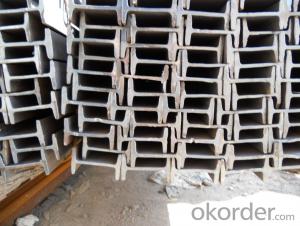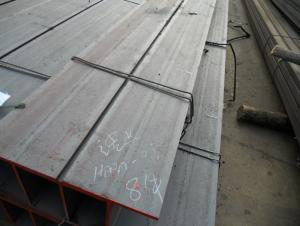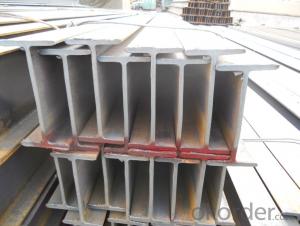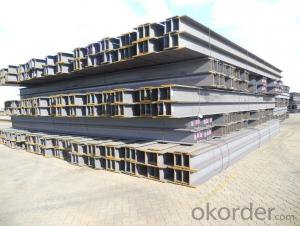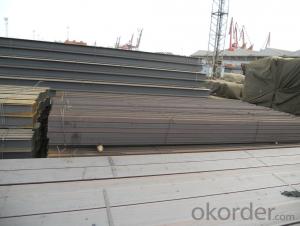Alloy Low Carbon Steel I Beam for Structure
- Loading Port:
- China Main Port
- Payment Terms:
- TT or LC
- Min Order Qty:
- 50 m.t.
- Supply Capability:
- 10000 m.t./month
OKorder Service Pledge
OKorder Financial Service
You Might Also Like
Product Description:
OKorder is offering Alloy Low Carbon Steel I Beam for Structure at great prices with worldwide shipping. Our supplier is a world-class manufacturer of steel, with our products utilized the world over. OKorder annually supplies products to African, South American and Asian markets. We provide quotations within 24 hours of receiving an inquiry and guarantee competitive prices.
Product Applications:
Alloy Low Carbon Steel I Beam for Structure are ideal for structural applications and are widely used in the construction of buildings and bridges, and the manufacturing, petrochemical, and transportation industries.
Product Advantages:
OKorder's Alloy Low Carbon Steel I Beam for Structure are durable, strong, and wide variety of sizes.
Main Product Features:
· Premium quality
· Prompt delivery & seaworthy packing (30 days after receiving deposit)
· Can be recycled and reused
· Mill test certification
· Professional Service
· Competitive pricing
Product Specifications:
Manufacture: Hot rolled
Grade: Q195 – 235
Certificates: ISO, SGS, BV, CIQ
Length: 6m-12m, as per customer request
Packaging: Export packing, nude packing, bundled
| SIZE | h(MM) | b(MM) | s(MM) | t(MM) | Mass: Kg/m | LENGTH |
| IPE100 | 100 | 55 | 4.10 | 5.70 | 8.10 | 6M/9M/12M |
| IPE120 | 120 | 64 | 4.80 | 6.30 | 10.40 | 6M/9M/12M |
| IPE140 | 140 | 73 | 4.70 | 6.90 | 12.90 | 6M/9M/12M |
| IPE160 | 160 | 82 | 5.00 | 7.40 | 15.80 | 6M/9M/12M |
| IPE200 | 200 | 100 | 5.60 | 8.50 | 22.40 | 6M/9M/12M |
| SIZE | h(MM) | b(MM) | s(MM) | t(MM) | Mass: Kg/m | LENGTH |
| IPEAA80 | 80 | 46 | 3.20 | 4.20 | 4.95 | 6M/9M/12M |
| IPEAA100 | 100 | 55 | 3.60 | 4.50 | 6.72 | 6M/9M/12M |
| IPEAA120 | 120 | 64 | 3.80 | 4.80 | 8.36 | 6M/9M/12M |
| IPEAA140 | 140 | 73 | 3.80 | 5.20 | 10.05 | 6M/9M/12M |
| IPEAA160 | 160 | 82 | 4.00 | 5.60 | 12.31 | 6M/9M/12M |
| IPEAA200 | 200 | 100 | 4.50 | 6.70 | 17.95 | 6M/9M/12M |
FAQ:
Q1: Why buy Materials & Equipment from OKorder.com?
A1: All products offered byOKorder.com are carefully selected from China's most reliable manufacturing enterprises. Through its ISO certifications, OKorder.com adheres to the highest standards and a commitment to supply chain safety and customer satisfaction.
Q2: How many tons of steel products could be loaded in containers?
A2: Usually the steel products are delivered by bulk vessel because of the large quantity and the freight. However, there are no bulk vessel enter some seaports so that we have to deliver the cargo by containers. The 6m steel product can be loaded in 20FT container, but the quantity is changed according to the size, usually from 18tons to 25tons.
Q3: How soon can we receive the product after purchase?
A3: Within three days of placing an order, we will arrange production. The normal sizes with the normal grade can be produced within one month. The specific shipping date is dependent upon international and government factors, the delivery to international main port about 45-60days.
Images:
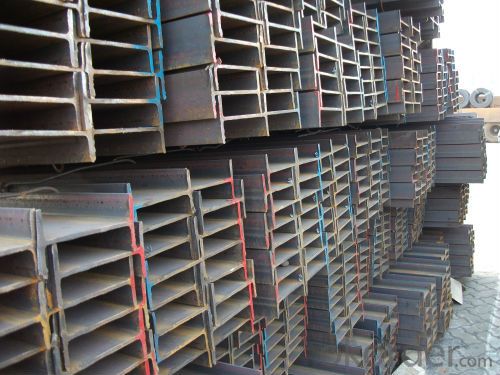
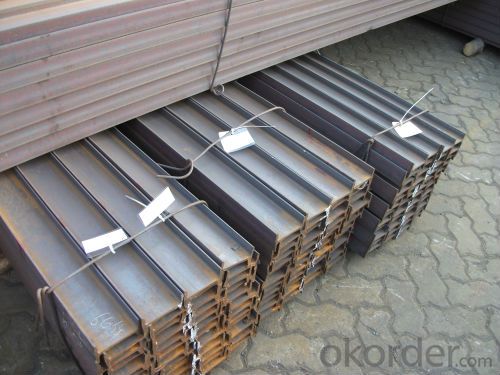
- Q:How do steel H-beams perform in dynamic loads?
- Steel H-beams are known for their excellent performance in dynamic loads. Due to their structural shape and high strength, H-beams are able to withstand dynamic forces and vibrations, making them suitable for applications where there is frequent movement or variable loads. Their robustness and ability to distribute loads evenly along the beam's length ensure stability and structural integrity, even in demanding dynamic conditions. Overall, steel H-beams are highly reliable and efficient in handling dynamic loads.
- Q:Are steel H-beams resistant to chemicals or corrosive substances?
- Steel H-beams are generally resistant to chemicals and corrosive substances. This is due to the inherent properties of steel, such as its high strength and durability. Steel is known for its resistance to chemical reactions and corrosion, making it a suitable material for various applications in industries where exposure to chemicals or corrosive substances is common. However, it is important to note that the resistance of steel H-beams to chemicals and corrosive substances can vary depending on the specific type of steel used and the nature of the chemicals or corrosive substances involved. In certain extreme conditions or highly aggressive environments, steel may still be susceptible to corrosion or chemical attack. To enhance the resistance of steel H-beams to chemicals and corrosive substances, additional protective measures can be applied. These may include coatings, such as galvanization or paint, which create a barrier between the steel surface and the surrounding environment. Regular maintenance and inspection are also crucial to identify and address any signs of corrosion or chemical damage promptly. Overall, while steel H-beams are generally resistant to chemicals and corrosive substances, it is important to consider the specific application and environment in order to determine the appropriate level of protection and maintenance required.
- Q:Are there any design guidelines or codes for using steel H-beams?
- Yes, there are design guidelines and codes that provide specifications and requirements for using steel H-beams in construction projects. These guidelines ensure the safe and efficient use of H-beams in various structural applications. One of the most widely recognized codes for steel structure design is the American Institute of Steel Construction (AISC) Specification for Structural Steel Buildings. This code provides comprehensive design guidelines, including the use of H-beams, for various types of structures such as buildings, bridges, and industrial facilities. It covers aspects such as material selection, member design, connection design, and fabrication requirements. The AISC code outlines requirements for designing steel H-beams, including load capacities, allowable stresses, and design criteria for different types of loading conditions such as gravity loads, wind loads, and seismic loads. It also provides guidance on the selection of appropriate beam sizes and shapes based on the structural requirements and the applied loads. Other design guidelines and codes, such as the Eurocode, British Standards, and Canadian Standards, also provide specifications for the use of steel H-beams in construction projects. These codes may have slight variations in terms of design approaches and methodologies, but they generally cover similar topics and provide guidance on the safe and efficient use of H-beams. It is important to consult the relevant design codes and guidelines specific to your region or country when using steel H-beams in construction projects. Compliance with these codes ensures that the structural design is reliable, safe, and meets the required standards. Additionally, involving a qualified structural engineer during the design process is crucial to ensure that the H-beams are appropriately sized and detailed to meet the specific project requirements and local codes.
- Q:How do steel H-beams perform in extreme weather conditions such as hurricanes or cyclones?
- Steel H-beams excel in extreme weather conditions like hurricanes or cyclones due to their exceptional strength and durability. The inherent properties of steel, such as high tensile strength and resistance to corrosion, make H-beams capable of withstanding strong winds, heavy rainfall, and other severe elements. They provide structural stability and ensure the integrity of buildings and structures even in the face of extreme weather events.
- Q:Are steel H-beams suitable for use in the construction of residential houses?
- Yes, steel H-beams are suitable for use in the construction of residential houses. They provide excellent structural support, are durable, and can withstand heavy loads. Additionally, their versatility allows for flexibility in architectural designs, offering homeowners a wide range of possibilities.
- Q:Are Steel H-Beams suitable for multi-story buildings?
- Yes, steel H-beams are suitable for multi-story buildings. H-beams, also known as I-beams, are commonly used in construction due to their strength, versatility, and cost-effectiveness. The H shape provides excellent load-bearing capacity, allowing for the construction of tall and spacious structures. Steel H-beams are capable of supporting heavy loads and transferring them to the foundation, making them ideal for multi-story buildings. Additionally, steel is a durable material that resists fire, corrosion, and pests, ensuring the longevity and safety of the structure.
- Q:Can steel H-beams be used for supporting modular building systems?
- Yes, steel H-beams can be used for supporting modular building systems. They provide excellent structural support and can be easily integrated into the modular construction process.
- Q:How are steel H-beams used in building bridges?
- Steel H-beams are commonly used in building bridges due to their structural strength, durability, and ability to bear heavy loads. These beams are designed in the shape of an "H" to provide maximum strength and support when used horizontally as bridge girders. When constructing a bridge, steel H-beams are used to create the main framework or superstructure of the bridge. These beams are typically placed horizontally and span across the supports or piers of the bridge. They are often used in pairs, with a vertical column or pier in the center, to form a truss-like structure. The H-beams are joined together using welding or bolting techniques to ensure stability and rigidity. This allows them to distribute the weight of the bridge evenly, preventing any excessive stress or strain on specific sections. The beams are also designed to be resistant to bending or deformation, making them ideal for bridges that need to span long distances. In addition to their load-bearing capabilities, steel H-beams can also be used to support various bridge components, such as decks, railings, and utility systems. These beams can be integrated into the overall bridge design to provide additional strength and stability. Overall, steel H-beams are essential components in building bridges as they provide the necessary structural integrity, strength, and load-bearing capacity required for safe and efficient transportation. Their versatility and reliability make them a popular choice among engineers and bridge builders worldwide.
- Q:What's the difference between welded H - section steel and high frequency welded H - section steel and hot rolled H section steel?
- The shunt end piece (T profiles, H59 1 brass) two pieces with the resistance sheet (thickness of 1.5, 20 wide, 45 long, 5 pieces of copper manganese); in high frequency heating mode; copper phosphorus solder welding; brazing process requirements: less than or equal to 1min, focused on solving the problem: positioning and welding (before brazing the process of using gas welding method). The main technical and economic indicators: after welding product surface without oxidation, the welding quality is higher than that of gas welding; resistance welding end pieces and reliable, welding without melting and deformation resistance; ensure shunt; the production efficiency is increased by two times.
- Q:How do steel H-beams perform in snow-prone areas?
- Due to their structural integrity and strength, steel H-beams are well-suited for areas with heavy snowfall. Their H-shape design provides resistance against bending and twisting forces, making them suitable for handling substantial snow loads. The efficient weight distribution design of H-beams also reduces the risk of structural failure caused by accumulated snow. Furthermore, steel is a durable material that is unaffected by extreme cold temperatures or moisture, making it highly resistant to corrosion and deterioration from snow and ice. This durability ensures that the H-beams maintain their structural integrity even in harsh winter conditions. Moreover, steel H-beams offer versatility in construction, allowing for various designs and configurations that can meet the unique requirements of snow-prone areas. These beams can be fabricated to specific lengths and sizes, ensuring optimal load distribution and providing the necessary support to withstand heavy snowfall. In conclusion, steel H-beams are an excellent choice for construction in areas prone to snow. Their strength, durability, and versatility make them highly capable of withstanding heavy snow loads and maintaining structural integrity in challenging winter conditions.
1. Manufacturer Overview |
|
|---|---|
| Location | |
| Year Established | |
| Annual Output Value | |
| Main Markets | |
| Company Certifications | |
2. Manufacturer Certificates |
|
|---|---|
| a) Certification Name | |
| Range | |
| Reference | |
| Validity Period | |
3. Manufacturer Capability |
|
|---|---|
| a)Trade Capacity | |
| Nearest Port | |
| Export Percentage | |
| No.of Employees in Trade Department | |
| Language Spoken: | |
| b)Factory Information | |
| Factory Size: | |
| No. of Production Lines | |
| Contract Manufacturing | |
| Product Price Range | |
Send your message to us
Alloy Low Carbon Steel I Beam for Structure
- Loading Port:
- China Main Port
- Payment Terms:
- TT or LC
- Min Order Qty:
- 50 m.t.
- Supply Capability:
- 10000 m.t./month
OKorder Service Pledge
OKorder Financial Service
Similar products
New products
Hot products
Related keywords
